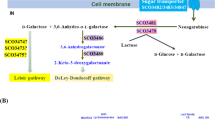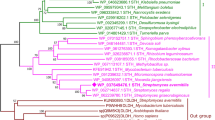Abstract
Arylsulfatase was purified from Sphingomonas sp. AS6330 through ionic exchange, hydrophobic- and gel-chromatographies. The purity increased 12,800-fold with approximately 19.1% yield against cell homogenate. The enzyme was a monomeric protein with apparent molecular weight of 62 kDa as determined by sodium dodecylsulfate-polyacrylamide gel electrophoresis, and 41 kDa as determined by gel filtration. The enzyme had optimum reaction conditions for hydrolysis of sulfate ester bonds in agar and p-nitrophenyl sulfate (NPS) at pH 7.0 and 45°C, with a specific activity of 3.93 and 97.2 U, respectively. The enzyme showed higher activity towards agar than other sulfated marine polysaccharides such as porphyran, fucoidan and carrageenan. The K m and V max of the enzyme for hydrolysis of NPS were 54.9 μM and 113 mM/min, respectively. With reaction of 200 g agar with 100 U arylsulfatase for 8 h at 45°C, gel strength increased 2.44-fold, and 97.7% of the sulfate in the agar was hydrolyzed.






Similar content being viewed by others
References
Akagawa-Matsushita M, Matsuop M, Koga Y, Yamasato K (1992) Alteromonas atlantica sp. nov. and Alteromonas carrageenovora sp. nov., bacteria that decompose algal polysaccharides. Int J Syst Bacteriol 42:621–627
Araki C (1937) Agar-agar. III. Acetylation of the agar-like substance of Gelidium amansii (L.). J Chem Soc Jpn 58:1338–1350
Barbeyron T, Potin P, Richard C, Collin O, Kloareg B (1995) Arylsulfatase from Alteromonas carrageenovora. Microbiology 141:2897–2904
Beil S, Kehrli H, Peter J, Staudenmann W, Cook AM, Leisinger T, Kertesz MA (1995) Purification and characterization of the arylsulfatase synthesized by Pseudomonas aeruginosa PAO during growth in sulfate-free medium and cloning of the arylsulfatase gene (atsA). Eur J Biochem 229:385–394
Bradford MM (1976) A rapid and sensitive method for the quantitation of microgram quantities of protein utilizing the principle of protein-dye binding. Anal Biochem 72:248–254
De Hostos EL, Togasaki RK, Grossman A (1988) Purification and biosynthesis of a derepressible periplasmic arylsulfatase from Chlamydomonas reinharditii. J Cell Biol 106:29–38
Dodgson KS, Price RG (1963) A note on the determination of the ester sulfate content of sulfated polysaccharides. Biochem J 84:350–356
Duckworth M, Yaphe W (1971) The structure of agar. Part 1. Fractionation of a complex mixture of polysaccharides. Carbohydr Res 16:189–197
Edwards SL, Dubin PL (1993) pH effects on non-ideal protein size-exclusion-exchange chromatography on Superose-6. J Chromatogr 648:3–7
Fleminger G, Solomon B, Wolf T, Hadas E (1990) Effect of polyethylene glycol on the non-specific adsorption of proteins to Eupergit C and agarose. J Chromatogr 510:271–279
Guiseley KB (1970) The relationship between methoxyl content and gelling temperature of agarose. Carbohydr Res 13:247–256
Guiseley KB, Kirpatrick FH, Provonchee RB, Dumais MM, Nochumson S (1993) A further fractionation of agarose. Hydrobiologia 260/261:505–511
Henderson MJ, Milazzo FH (1979) Arylsulfatase in Salmonella typhimurium: detection and influence of carbon source and tyramine on its synthesis. J Bacteriol 139:80–87
Hoshi M, Moriya T (1980) Arylsulfatase of sea-urchin sperm. 2. Arylsulfatase as a lysin of sea-urchins. Dev Biol 74:343–350
Izumi K (1970) A new method for fractionation of agar. Agric Biol Chem 34:1739–1740
Jansen HJ, Hart CA, Rhodes JM, Saunders JR, Smalley JW (1999) A novel mucin-sulphatase activity found in Burkholderia cepacia and Pseudomonas aeruginosa. J Med Microbiol 48:551–557
Kertesz MA (1999) Riding the sulfur cycle-metabolism of sulfonates and sulfate esters in Gram-negative bacteria. FEMS Microbiol Rev 24:135–175
Laas T (1972) Agar derivative for chromatography, electrophoresis and gel-bound enzymes. II. Charge-free agar. J Chromatogr 66:347–355
Laemmli UK (1970) Cleavage of structural proteins during the assembly of the head of bacteriophage T4. Nature 227:680–686
Lonnerdal B, Laas T (1976) Improved agarose for immunoelectrophoresis. Anal Biochem 72:527–532
Mackie W, Preston RD (1974) Cell wall and intracellular region polysaccharides. In: Stewart WDP (eds) Algal physiology and biochemistry. Blackwell, Oxford, pp 64–65
Marinho-Soriano E, Silva TSF, Moreira WSC (2001) Seasonal variation in the biomass and agar yield from Gracilaria cervicornis and Hydropuntia cornea from Brazil. Bioresour Technol 77:115–120
Miech C, Dierks T, Selmer T, von Figura K, Schmidt B (1998) Arylsulfatase from Klebsiella pneumoniae carries a formylglycine generated from a serine. J Biol Chem 273:4835–4837
Milanesi AA, Bind JWC (1972) Lysosomal enzymes in aquatic species II. Distribution and particle properties of thermally acclimated muscle lysosomes of rainbow trout Salmo gairdeneri. Comp Biochem Physiol 41:473–491
Provonchee RB (1991) Agarose purification method using glycol. US Patent 4 990 611
Selby HH, Whistler RL (1993) Agar. In: Whistler RL, BeMiller JN (eds) Industrial gums. Academic Press, New York, pp 87–103
Seo HJ, Kim JH, Byun DS, Kim HR (2001) Purification and characterization of arylsulfatase produced from Sphingomonas sp. nov. 75th Japanese Society of Fisheries Science, Yokohama, 4–7 October 2001
Tazuke Y, Matsuda K, Adachi K, Tsukada Y (1998) Purification and properties of a novel sulfatase from Pseudomonas testosteroni that hydrolyzed 3β-hydroxy-5-cholenoic acid 3-sulfate. Biosci Biotechnol Biochem 62:1739–1744
Ueki T, Sawada Y, Fukagawa Y, Oki T (1995a) Arylsulfatase from Streptomyces griseorubiginosus S980-14. Biosci Biotechnol Biochem 59:1062–1068
Ueki T, Hawada Y, Fukagawa Y, Oki T (1995b) A new type of arylsulfatase with high affinity to the sulfuryl moiety of the substrate. Biosci Biotechnol Biochem 59:1069–1075
Wieme RJ (1965) Agar gel electrophoresis. Elsevier, New York, pp 110–113
Yoon HS, Park YH (1984) Studies on the composition of agarose and agartin in agar-agar. Bull Korean Fish Soc 24:27–33
Acknowledgement
This work was supported by Korea Research Foundation Grant (KRF-2001-015-HP0001).
Author information
Authors and Affiliations
Corresponding author
Rights and permissions
About this article
Cite this article
Kim, JH., Byun, DS., Godber, J.S. et al. Purification and characterization of arylsulfatase from Sphingomonas sp. AS6330. Appl Microbiol Biotechnol 63, 553–559 (2004). https://doi.org/10.1007/s00253-003-1463-8
Received:
Revised:
Accepted:
Published:
Issue Date:
DOI: https://doi.org/10.1007/s00253-003-1463-8




